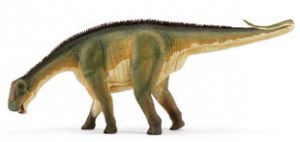Latest Research Findings on Nigersaurus
As Dinosaurs dominated life on Earth during the latter part of the Mesozoic they diversified into many varied forms, each genus adapting to a specific way of life and filling an ecological niche.
Further research has just been published (November 2007), on a particularly bizarre looking sauropod from Africa – Nigersaurus.
Nigersaurus
Nigersaurus was first described in 1976 but little was known about this diplodocoid sauropod as although many isolated bones and fragments of fossils had been recovered very few were found in any form of association or articulation, so piecing together a complete picture of this animal was proving difficult. Nigersaurus (means “Niger lizard”) has been found in the fossil rich sediments of the Elrhaz Formation in the Niger Republic – Africa.
A rich variety of fauna has been recovered from this particular fossil site including fossils of the iguanodont Ouranosaurus and the huge, ancient crocodile Sarcosuchus, however because of the nature of the bones of Nigersaurus (highly pneumatic – filled with air spaces) and the delicate structure of the skull the remains of Nigersaurus were often overlooked in favour of better preserved and articulated specimens.
Now research published in the scientific journal “The Public Library of Science” building on work carried out by the American palaeontologist, Paul Sereno (University of Chicago), and his colleagues has shed new light on this remarkable animal.
A Cretaceous Dinosaur
Nigersaurus lived during the Cretaceous, fossil evidence suggests that these type of animals were around from 119 to approximately 99 million years ago (Aptian and Albian faunal stages). It was a member of the rebbachisaur family, a group of sauropods from the southern continents and Europe. Estimates of size vary but it is believed that Nigersaurus grew to lengths of around 10 metres and when compared to more typical diplodocoids its neck was considerably shorter. The most remarkable feature of the rebbachisaurs, and very evident in Nigersaurus was the extensive battery of sophisticated teeth. Nigersaurus had upwards of 600 teeth in its jaws. These teeth were arranged in rows along the front edges of the jaws, forming effective 30 cm long shears for cropping vegetation.
Study of the head and neck vertebrae indicate that the head was held close to the ground and Nigersaurus was probably a low level browser, shearing away at ferns, horsetails and other ground level plants like a cow grazing.
A Picture of a Nigersaurus Model
Using CT scans to reveal the strange dentition in the jaws, scientists have calculated that each row of teeth had at least 9 replacement teeth ready in the jaws ready to erupt through the bone and replace any teeth lost. The mouth parts of Nigersaurus have been described as a huge vacuum cleaner, hoovering up vegetation as it went along. The ultra light skull and back bones had made this animal difficult to study, but the CT scan showed the placement of delicate canals in the brain-case area and research into their orientation indicates that Nigersaurus spent most of its time with its head lowered to the ground.
It is not known whether Nigersaurus had thick lips or a prehensile trunk to assist it with feeding, other similar appendages have been speculated for diplodocoids but as soft tissue rarely fossilises, no evidence for this has been found.
The Position of the Eyes
The eyes were positioned relatively high on the skull and like all other sauropods were on the side of the head, this enabled Nigersaurus to keep a careful watch out for predators as it grazed with its head facing the ground. Living in herds would also have provided protection as in a group some animals would be feeding whilst others would have had their heads raised keeping watch for hungry theropods. The close cropping action of Nigersaurus may have influenced the evolution of plants with many of the angiosperms (flowering plants) developing a low to the ground growing habit. Grass for example, has an adaptation to overcome grazing as the growing point of the plant is at soil level thus permitting the plants to grow back after having been grazed.
There is no evidence of grass from this particular part of the Cretaceous, perhaps further research into the palynology (study of microfossils such as spores and pollen) will provide further information of the flora around at the time of Nigersaurus.
From evidence recovered in numerous expeditions, Nigersaurus has been formerly named and described – Nigersaurus taqueti by Paul Sereno and his team. The species name ascribed to this animal honours the French palaeontologist Philippe Taquet who first uncovered the strange lightweight, air sac filled bones of this animal. The peculiar dentition of rebbachisaurids, a sort of battery of cropping teeth is an example of parallel evolution within dinosaurs. Groups of ornithischian dinosaurs such as hadrosaurs and ceratopsians also developed batteries of many hundreds of teeth, but in these bird-hipped dinosaurs the teeth were located towards the back of the jaws and formed an immense grinding service to help them cope with their tough diet.
Keeping your head close to ground was a dangerous habit during the middle Cretaceous. Nigersaurus shared its world with a number of top predators including spinosaurids, carcharodontosaurids and abelisaurs.
Even lakes and rivers held their dangers, fossils of Sarcosuchus (means “flesh crocodile”) have been found in the same deposits as Nigersaurus. This primitive crocodile grew to lengths of 40 feet or more and weighed an estimated 8 tonnes, certainly big enough to ambush a young Nigersaurus as it came down to drink.
Dinosaur Toys and Dinosaur Models: Dinosaur and Prehistoric Animal Models.







sus
Hella sus